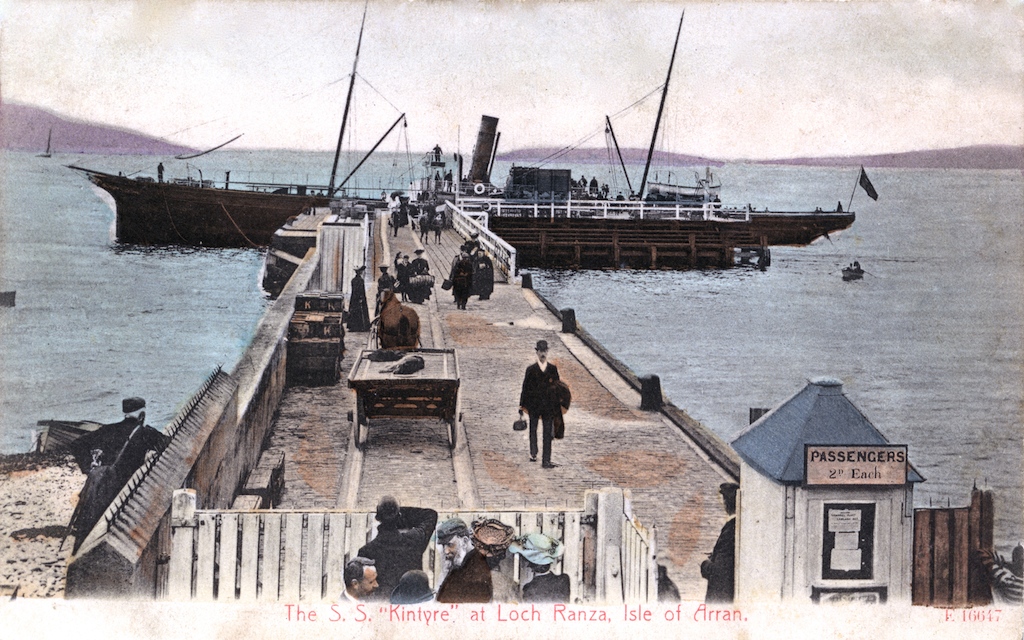 Since the first Clyde steamer Comet appeared in 1812, numerous companies have run passenger services on the river; even today we still have a handful. From the meek Henderson & McKellar to the mighty Caledonian Steam Packet Company, each operated vessels which graced the waters of our Firth.
Since the first Clyde steamer Comet appeared in 1812, numerous companies have run passenger services on the river; even today we still have a handful. From the meek Henderson & McKellar to the mighty Caledonian Steam Packet Company, each operated vessels which graced the waters of our Firth.
In this brand new series we pick out the ships that were ‘Pride of the Fleet’ of the various steamer companies. To start off the series, Stuart Craig takes a look at the Campbeltown & Glasgow Steam Packet Joint Stock Company Ltd, and why look further than their beautiful steamship Kintyre.
I have chosen SS Kintyre for she was undoubtably a beautiful ship. But her story is all the more poignant because this lovely vessel met such a dreadful end.
The Campbeltown & Glasgow Steam Packet Joint Stock Company Ltd was formed in 1826 and had a long pedigree running steamers from Glasgow to Campbeltown (usually via Greenock, Wemyss Bay, Lochranza, Pirnmill and Carradale). After operating a handful of vessels on this long route the company was made to step-up-to-the-mark when another company started in competition to them in 1866. The reaction of the Campbeltown company was to introduce the robust paddler Gael, followed a couple of years later by the stylish, clipper-bowed, screw-driven Kintyre. Vessels of a similar style were built for the company over the next 60 years, including Kinloch, Davaar and Dalriada. All featured the company’s black funnel with broad red band.
Kintyre was launched at the yard of Robertson and Co of Greenock on 10 June 1868, as a consort to Gael on the Glasgow to Campbeltown run. She was 184 feet in length and, powered by a double cylinder Blackwood & Gordon engine, she could achieve 14 knots. She was the first screw-driven vessel built for this route and with her unusual bow design was generally considered to be one of the most graceful ships on the Clyde. For a contemporary assessment of her, one can turn to Duckworth and Langmuir’s book Clyde River and Other Steamers, which quotes a Campbeltown Courier correspondent:“She was inimitable…. Her successors were but sorry imitations of her beauty. She was the finest design of a screw steamer that ever sailed the Clyde. And her like will be no more!”
On Wednesday 18 September 1907, during daylight hours, she was struck off Skelmorlie by the steamship Maori. Maori had been built at Denny’s and was completing her trials before heading off to New Zealand. Kintyre was heading south and, spotting Maori approaching, her skipper Captain MacKechnie exchanged signals with his counterpart. The New Zealand vessel was instigating a wide turn to starboard towards Wemyss Bay, but Kintyre failed to give way and cut across the front of her. Maori ploughed into the starboard side of the Campbeltown-bound steamer. Both her Captain and Chief Engineer William Lennox were thrown into the sea; Captain MacKechnie managed to be picked up but the chief was less fortunate and lost his life.
The wreck of Kintyre is still recognisable to the diver, some 40 metres deep, south of Wemyss Point, her graceful clipper bow rising high from the seabed. Sadly the wreck claimed another life in 2012 when a diver died of ‘bends’ after visiting the ship.
Like a fated princess, this was such a tragic end to so beautiful a ship.
Do you have your own ‘pride of the fleet’ from a different company? Perhaps you have your own favourite, which you would pick out as the most beautiful or most stylish that sailed under a particular company flag. Please send your contribution to info@crsc.org.uk













